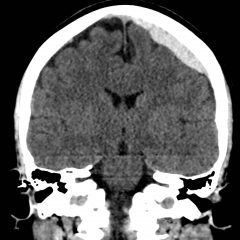Presentation of Significant Subarachnoid Hemorrhage without Loss of Consciousness
History of present illness:
A 68-year-old female with history of hypertension presented to the emergency department one hour after the sudden onset of 10/10 headache. The patient had a history of headaches, but described this episode as the “worst of her life” with associated vomiting, mild neck pain with movement, increased light sensitivity, and generalized weakness. The patient denied focal weakness or changes in vision. On exam, the patient was awake and alert with no slurred speech. Gait was intact and strength was 5/5 bilaterally in the upper and lower extremities. She had no facial asymmetry.
Significant findings:
A non-contrast head CT demonstrated extensive subarachnoid hemorrhage occupying both cerebral convexities, the anterior interhemispheric fissure, the sylvian fissures, and the basal cisterns. Later CTA would show an 8 mm by 7 mm by 8mm MCA aneurysm near the M1/M2 junction and two pericallosal artery aneurysms, 7 by 6 mm and 8 by 5 mm respectively.
The patient underwent external ventricular drain (EVD) placement by neurosurgery, followed by coiling of the three aneurysms by interventional radiology.
Discussion:
Subarachnoid hemorrhages account for 10 percent of cerebrovascular accidents, with mortality rates approaching 50 percent. Most subarachnoid hemorrhages are due to ruptured saccular aneurysms located at bifurcations of arteries within the circle of Willis. Other causes include trauma or AV malformations. Common complications of SAH include vasospasms, cerebral tissue infarction, seizure, and cardiac complications.1
In addition to the sudden severe headache seen in 97 percent of cases, 50 percent of patients experience transient loss of consciousness, and many experience vomiting, meningeal irritation, nuchal rigidity, and photosensitivity.2 One retrospective series evaluating proven non-traumatic, spontaneous subarachnoid hemorrhages found nausea or vomiting in 77 percent of patients, loss of consciousness in 53 percent, and meningismus in 35 percent.3 Non-contrast head CT performed within six hours of headache onset has a sensitivity and specificity approaching 100 percent.4 After six hours, patients should also be evaluated with lumbar puncture and/or CT or magnetic resonance (MR) angiography.4
Topics:
SAH, subarachnoid hemorrhage, headache, aneurysm, non-contrast head CT.
References:
- Van der Bilt IA, Hasan D, Vandertop WP, Wilde AA, Algra A, Visser FC, et al. Impact of cardiac complications on outcome after aneurysmal subarachnoid hemorrhage: a meta-analysis. Neurology. 2009;72(7):635-642. doi: 10.1212/01.wnl.0000342471.07290.07
- Gorelick PB, Hier DB, Caplan LR, Langenberg P. Headache in acute cerebrovascular disease. Neurology. 1986;36(11):1445-1450.
- Fontanarosa PB. Recognition of subarachnoid hemorrhage. Ann Emerg Med. 1989;18(11):1199-1205.
- Perry JJ, Stiell IG, Sivilotti ML, et al. Sensitivity of computed tomography performed within six hours of onset of headache for diagnosis of subarachnoid haemorrhage: prospective cohort study. BMJ. 2011;343:d4277. doi: 10.1136/bmj.d4277





